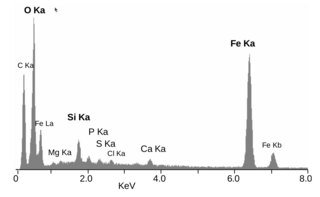Related Research Articles

Analytical chemistry studies and uses instruments and methods used to separate, identify, and quantify matter. In practice, separation, identification or quantification may constitute the entire analysis or be combined with another method. Separation isolates analytes. Qualitative analysis identifies analytes, while quantitative analysis determines the numerical amount or concentration. Analytical chemistry is the science of obtaining, processing, and communicating information about the composition and structure of matter. In other words, it is the art and science of determining what matter is and how much of it exists. ... It is one of the most popular fields of work for ACS chemists.

Spectroscopy is the study of the interaction between matter and electromagnetic radiation as a function of the wavelength or frequency of the radiation. In simpler terms, spectroscopy is the precise study of color as generalized from visible light to all bands of the electromagnetic spectrum; indeed, historically, spectroscopy originated as the study of the wavelength dependence of the absorption by gas phase matter of visible light dispersed by a prism. Matter waves and acoustic waves can also be considered forms of radiative energy, and recently gravitational waves have been associated with a spectral signature in the context of the Laser Interferometer Gravitational-Wave Observatory (LIGO).

X-ray fluorescence (XRF) is the emission of characteristic "secondary" X-rays from a material that has been excited by being bombarded with high-energy X-rays or gamma rays. The phenomenon is widely used for elemental analysis and chemical analysis, particularly in the investigation of metals, glass, ceramics and building materials, and for research in geochemistry, forensic science, archaeology and art objects such as paintings.
Gold fingerprinting is a method of identifying an item made of gold based on the impurities or trace elements it contains.

Energy-dispersive X-ray spectroscopy, sometimes called energy dispersive X-ray analysis or energy dispersive X-ray microanalysis (EDXMA), is an analytical technique used for the elemental analysis or chemical characterization of a sample. It relies on an interaction of some source of X-ray excitation and a sample. Its characterization capabilities are due in large part to the fundamental principle that each element has a unique atomic structure allowing a unique set of peaks on its electromagnetic emission spectrum. The peak positions are predicted by the Moseley's law with accuracy much better than experimental resolution of a typical EDX instrument.
Archaeological science, also known as archaeometry, consists of the application of scientific techniques to the analysis of archaeological materials and sites. It is related to methodologies of archaeology. Martinón-Torres and Killick distinguish ‘scientific archaeology’ from ‘archaeological science’. Martinón-Torres and Killick claim that ‘archaeological science’ has promoted the development of high-level theory in archaeology. However, Smith rejects both concepts of archaeological science because neither emphasize falsification or a search for causality.

X-ray spectroscopy is a general term for several spectroscopic techniques for characterization of materials by using x-ray radiation.

Elemental analysis is a process where a sample of some material is analyzed for its elemental and sometimes isotopic composition. Elemental analysis can be qualitative, and it can be quantitative. Elemental analysis falls within the ambit of analytical chemistry, the set of instruments involved in deciphering the chemical nature of our world.
Microanalysis is the chemical identification and quantitative analysis of very small amounts of chemical substances or very small surfaces of material. One of the pioneers in the microanalysis of chemical elements was the Austrian Nobel Prize winner Fritz Pregl.
Lithium metaborate (LiBO2) is a chemical compound.
Micro x-ray fluorescence (µXRF) is an elemental analysis technique that relies on the same principles as x-ray fluorescence (XRF). Synchrotron X-rays may be used to provide elemental imaging with biological samples. The spatial resolution diameter of micro x-ray fluorescence is many orders of magnitude smaller than that of conventional XRF. While a smaller excitation spot can be achieved by restricting x-ray beam using a pinhole aperture, this method blocks much of the x-ray flux which has an adverse effect on the sensitivity of trace elemental analysis. Two types of x-ray optics, polycapillary and doubly curved crystal focusing optics, are able to create small focal spots of just a few micrometers in diameter. By using x-ray optics, the irradiation of the focal spot is much more intense and allows for enhanced trace element analysis and better resolution of small features. Micro x-ray fluorescence using x-ray optics has been used in applications such as forensics, small feature evaluations, elemental mapping, mineralogy, electronics, multi-layered coating analysis, micro-contamination detection, film and plating thickness, biology and environment.
SPECTRO Analytical Instruments is a manufacturer of elemental analyzers using optical emission spectroscopy and x-ray fluorescence spectrometry. The company's headquarters are located in Kleve, Germany.

A metallurgical assay is a compositional analysis of an ore, metal, or alloy, usually performed in order to test for purity or quality.
Semiconductor characterization techniques are used to characterize a semiconductor material or device. Some examples of semiconductor properties that could be characterized include the depletion width, carrier concentration, carrier generation and recombination rates, carrier lifetimes, defect concentration, and trap states.
Ancient iron production refers to iron working in times from prehistory to the early Middle Ages where knowledge of production processes is derived from archaeological investigation. Slag, the byproduct of iron-working processes such as smelting or smithing, is left at the iron-working site rather than being moved away with the product. It also weathers well and hence it is readily available for study. The size, shape, chemical composition and microstructure of slag are determined by features of the iron-working processes used at the time of its formation.

Instrumental analysis is a field of analytical chemistry that investigates analytes using scientific instruments.
Spectroscopy is a trade magazine published since 1985. Spectroscopy has an editorial goal to promote and support the use of spectroscopic instrumentation in applied research, environmental testing, quality control, and the life sciences.
Ionomics is the measurement of the total elemental composition of an organism to address biological problems. Questions within physiology, ecology, evolution, and many other fields can be investigated using ionomics, often coupled with bioinformatics and other genetic tools. Observing an organism's ionome is a powerful approach to the functional analysis of its genes and the gene networks. Information about the physiological state of an organism can also be revealed indirectly through its ionome, for example iron deficiency in a plant can be identified by looking at a number of other elements, rather than iron itself. A more typical example is in a blood test, where a number of conditions involving nutrition or disease may be inferred from testing this single tissue for sodium, potassium, iron, chlorine, zinc, magnesium, calcium and copper.
References
- ↑ "Positive Material Identification (PMI)". www.intertek.com. Retrieved 13 January 2019.
- ↑ "Positive Material Identification PMI XRF OES | Responsive Ltd".
- ↑ "Positive Material Identification PMI XRF OES | Responsive Ltd".